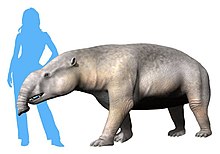| Astrapotheria | |
|---|---|

| |
| Skull of Astrapotherium | |

| |
| Reconstruction of Astrapotherium | |
| Scientific classification | |
| Domain: | Eukaryota |
| Kingdom: | Animalia |
| Phylum: | Chordata |
| Class: | Mammalia |
| Clade: | †Meridiungulata |
| Order: | †Astrapotheria Lydekker 1894[1] |
| Families | |
|
† Astrapotheriidae | |
Astrapotheria is an extinct order of South American[2] and Antarctic[3] hoofed mammals that existed from the late Paleocene to the Middle Miocene, 59 to 11.8 million years ago.[2] Astrapotheres were large, rhinoceros-like animals and have been called one of the most bizarre orders of mammals with an enigmatic evolutionary history.[4]
The taxonomy of this order is not clear, but it may belong to Meridiungulata (along with Notoungulata, Litopterna, Pyrotheria and Xenungulata). In turn, Meridungulata is believed to belong to the extant superorder Laurasiatheria. Some scientists have regarded the astrapotheres (and sometimes the Meridiungulata as a whole) as members of the clade Atlantogenata. However, collagen and mitochondrial DNA sequence data analysed in 2015 places at least the notoungulates and litopterns firmly within Laurasiatheria, as a sister group to the perissodactyls.[5][6][7]
- ^ Astrapotheria in the Paleobiology Database. Retrieved March 2013
- ^ a b "The uruguaytheriine Astrapotheriidae from the rich middle Miocene Honda Group of the upper Magdalena River valley in Colombia (...) are the youngest securely dated remains of that order in South America." Johnson & Madden 1997, p. 356
- ^ Bond, M.; Kramarz, A.; MacPhee, R. D. E.; Reguero, M. (2011). "A new astrapothere (Mammalia, Meridiungulata) from La Meseta Formation, Seymour (Marambio) Island, and a reassessment of previous records of Antarctic astrapotheres" (PDF). American Museum Novitates (3718): 1–16. doi:10.1206/3718.2. hdl:2246/6118. S2CID 58908785.
- ^ Rose 2006, pp. 235–6
- ^ Welker, F.; Collins, M. J.; Thomas, J. A.; Wadsley, M.; Brace, S.; Cappellini, E.; Turvey, S. T.; Reguero, M.; Gelfo, J. N.; Kramarz, A.; Burger, J.; Thomas-Oates, J.; Ashford, D. A.; Ashton, P. D.; Rowsell, K.; Porter, D. M.; Kessler, B.; Fischer, R.; Baessmann, C.; Kaspar, S.; Olsen, J. V.; Kiley, P.; Elliott, J. A.; Kelstrup, C. D.; Mullin, V.; Hofreiter, M.; Willerslev, E.; Hublin, J.-J.; Orlando, L.; Barnes, I.; MacPhee, R. D. E. (2015-03-18). "Ancient proteins resolve the evolutionary history of Darwin's South American ungulates" (PDF). Nature. 522 (7554): 81–84. Bibcode:2015Natur.522...81W. doi:10.1038/nature14249. ISSN 0028-0836. PMID 25799987. S2CID 4467386.
- ^ Buckley, M. (2015-04-01). "Ancient collagen reveals evolutionary history of the endemic South American 'ungulates'". Proceedings of the Royal Society B: Biological Sciences. 282 (1806): 20142671. doi:10.1098/rspb.2014.2671. PMC 4426609. PMID 25833851.
- ^ Westbury, M.; Baleka, S.; Barlow, A.; Hartmann, S.; Paijmans, J. L. A.; Kramarz, A.; Forasiepi, A. M.; Bond, M.; Gelfo, J. N.; Reguero, M. A.; López-Mendoza, P.; Taglioretti, M.; Scaglia, F.; Rinderknecht, A.; Jones, W.; Mena, F.; Billet, G.; de Muizon, C.; Aguilar, J. L.; MacPhee, R. D. E.; Hofreiter, M. (2017-06-27). "A mitogenomic timetree for Darwin's enigmatic South American mammal Macrauchenia patachonica". Nature Communications. 8: 15951. Bibcode:2017NatCo...815951W. doi:10.1038/ncomms15951. PMC 5490259. PMID 28654082.